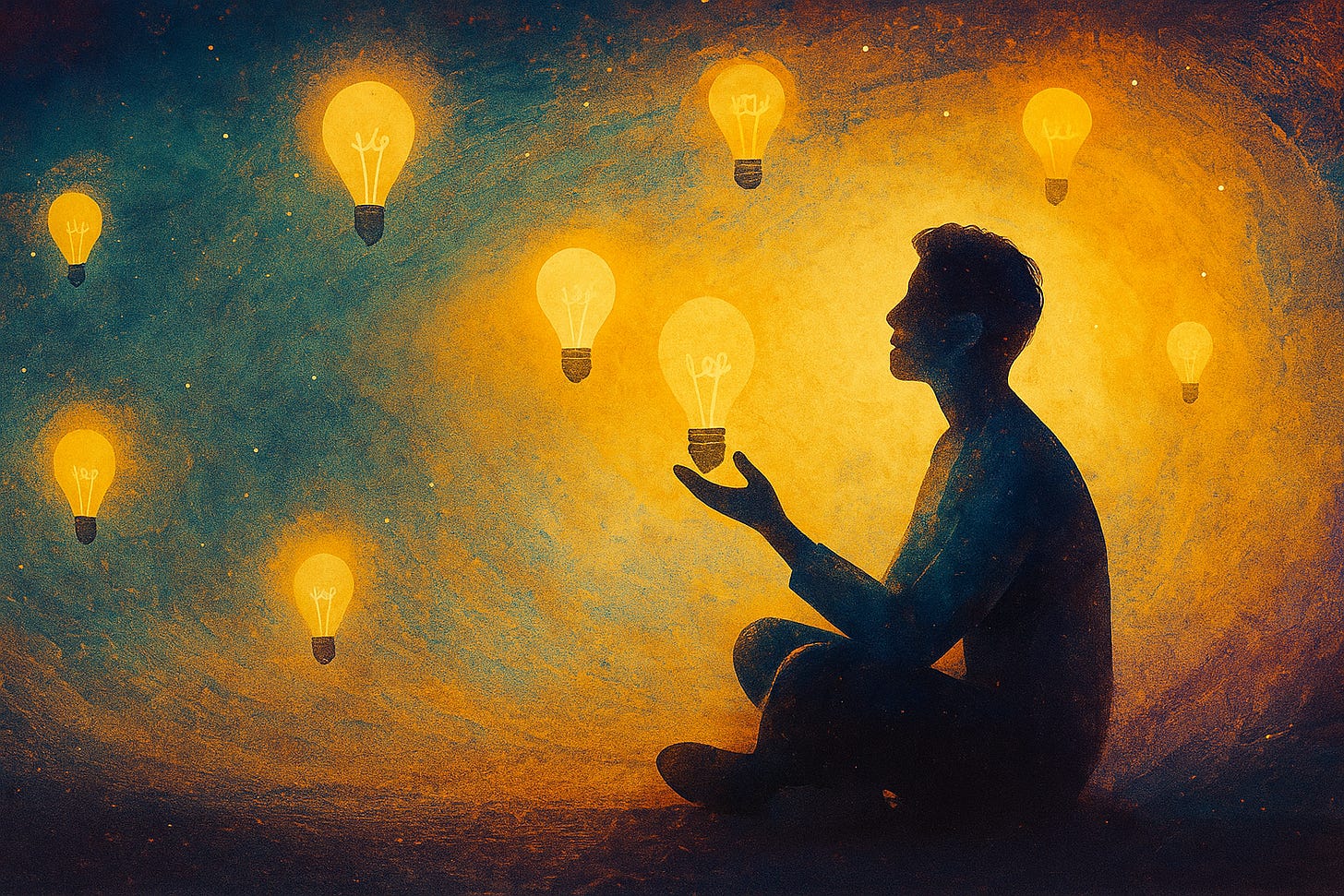Tuned to Life: What If Ideas Choose You?
A written reflection inspired by Episode #72 of The Unreasonable Art of Living on where ideas come from, why people matter more than ideas, and how to stay open to creation.
The Myth of the “Great Idea”
Ideas come from people; hence, people are more important than ideas. Why are we confused about this? It is a beautiful, creative paradox.
Too many of us think of ideas as being the end, as if they come fully formed and fledged out. Perhaps we are the one great idea. Yet, ideas coming through you are just the beginning. Ideas are the initial spark, an initial feeling, or perhaps even an initial glimpse. It is an initial impulse to get you to act.
Ideas, though, are not singular, fully formed packages. They are forged through thousands of discussions, decisions, failures, and experiments, often made by many people.
I will be the first to raise my hand in admitting to falling for this error in thinking. For a long time, I was more focused on the idea itself than on what every investor kept preaching: they invest in teams, not ideas, especially in the early stage.
It took me a while to realize what that really meant. In the startup world, the idea is often treated as the holy grail. But are we truly holding an idea, or still searching for one?
Two invaluable startup failures later, I finally moved from understanding the idea in theory to fully embodying it.
Ideas are abundant. The people who can receive them, hold them, and act on them are rare.
We are the receivers: our body the antenna, our emotions and intuition the signal, our attention the frequency we tune to.
What matters is how well we’re tuned.
Where Ideas Come From: We Are Vessels & Receivers, Not Owners
Let’s be honest, everyone’s had an idea in the shower. Chances are, you weren’t the only one. Many people around the world probably received the exact same idea at the exact same moment.
In that sense, you’re no more special than anyone else, just another receiver tuned to the same frequency.
We think ideas are ours, but they visit many at once.
As Rick Rubins said it beautifully
“We are all pariticipating in a larger creative act we are not conducting. We are being conducted. The artist is on a cosmic timetable, just like all of nature. If you have an idea you’re excited about and you don’t bring it to life, it’s not uncommon for the idea to find its voice through another maker. This isn’t because the other artist stole your idea, but because the idea’s time has come.”
Receiving ideas is something unique to us humans, almost like an invitation. The Universe, nature, God, consciousness, or whatever you want to call it, wants ideas to be born, broadcasting them to an array of suitable receivers. Some answer the call; some don’t.
This also means that you will see the same idea being manifested in different shapes and forms, but with the same essence. Nature just knows how to evolve.
The funny thing is, evolution itself learns through failure. Many ideas fail. Some exist only to inspire others. Some stay for a moment, some last millennia. But nothing lives forever. Everything we create has a beginning, middle, and end.
Ideas visit us. They float around. The better we, the receivers, are tuned, the more ideas we notice, and the more invitations we receive to bring them into form.
What a gift that is. What an honor.
We don’t control when they knock, but we control how ready we are to receive. We control with what intention and energy we want to manifest this idea through us and other people.
Of course, like all things in life, there’s a shadow side to creation.
“To every human is given a key to the gates of heaven. The same key opens the gates of hell.” - Buddhist proverb
Nature, the universe, is messy.
It’s a constant cycle of creation and destruction, love and hate, collaboration and competition. One cannot exist without the other, some argue. In that tension, everything grows.
Our task isn’t to invent ideas out of nothing, but to stay awake enough to notice when one passes through, and brave enough to bring it to life.
People Over Ideas: Oppenheimer, Pixar, and A-Players
The story of the Manhattan Project is often told as the triumph of a single, brilliant idea: the harnessing of atomic energy. But in truth, it was the story of two people: General Leslie Groves and J. Robert Oppenheimer.
Two opposites, one a pragmatic engineer and organizer, the other a creative visionary and scientist.
The success wasn’t born from a single genius or a perfect plan, but from the interplay between structure and imagination, execution and intuition. It wasn’t the idea that changed history. It was the people and the container that allowed the idea to take form.
The same is true at Pixar.
Ed Catmull once said he’d rather have a mediocre idea with a great team than a great idea with a mediocre team. Pixar even budgeted a third of its creative energy on projects that would “fail the elevator test”, ideas too strange or original to explain in thirty seconds, trusting that the right people could turn the impossible into something beloved.
When you read the biographies of great founders and creators, most of whom aren’t with us anymore, you’ll find the same pattern: they hired for peaks, not plateaus. They understood that those with great heights often carry deep lows. And that’s okay. That’s human.
Because ideas don’t execute themselves. People do.
A-players attract A-players. They challenge, stretch, and sharpen each other. And the magic happens when their differences don’t cancel out but compound.
The danger lies in trying to hire for balance, for sameness. Smoothing the edges of the very people who could make something extraordinary.
The world trains us to iron out our extremes, to become well-rounded, predictable, “easy to manage.” But originality lives in the peaks, in the intensity of character, the obsession, the restlessness, the imperfection.
To lead or create is to hold space for that full spectrum: your own, and the people around you. Because an idea without the right people is just a sentence in a notebook.
Being an Artist: A Uniquely Human Role
Many who do not engage in the traditional arts might hesitate to identify themselves as artists. Perhaps, for them, creativity is something reserved for a chosen few. But that is not true. Creativity is not a rare ability, nor is it difficult to access. It is our birthright. To create means to bring something into existence that wasn’t there before.
You are an artist.
Let me prove it to you.
Have you had a conversation today?
Perhaps you proposed a solution to a problem?
Did you write a message to a friend, a family member, a colleague, or a stranger?
Did you cook something?
Did you comb your hair beautifully?
Did you write in your journal?
Did you breathe in and out, changing the environment around you?
If you could answer yes to any of these questions, congratulations, you are an artist. If not, you might be a robot or an alien. In that case, welcome to Earth ✌️☮️.
What you make doesn’t have to be significant in the eyes of others, earn you money, or have a big impact on the world. Just by being, you are contributing to the greatest piece of art ever created: life itself.
Life is an ever-changing, evolving canvas. And you, right now, in this single moment, play a part in it. We create collectively, for ourselves, and for one another.
Because to live as an artist is a way of being in the world. It is a way of looking at life, of understanding who you are, and why you are here.
Perhaps it is the point where opportunity meets chance, where purpose meets plan. A new possibility, a new dance.
To live life as an artist is a practice of paying attention. It is a prayer without any gurus and “-isms”. Your own unique prayer: an act of appreciation for the human race, for nature, for the Universe, and everything in between.
In this sense, your entire life becomes a form of self-expression.
A creative being, in a creative world.
Your task is to tune your receiver to the best of your ability, because:
“The object isn’t to make art, it’s to be in that wonderful state which makes art inevitable.” - Robert Henri
To live as an artist is not about what you make, but how deeply you live.
Every breath, every word, every act of attention becomes a brushstroke on the canvas of life.
How to Nurture Ideas and Act on Them
Ideas don’t flourish in cluttered minds or exhausted bodies. They need space, silence, and energy to land.
Take care of your body. Eat consciously. Move often. A healthy body is the foundation of a clear receiver.
Learn to tune in. Meditate. Work with your emotions, find people who help you learn to truly feel again, not just talk about feelings.
Cry. Laugh. Be angry. Feel fear. Allow shame when you’ve done something wrong, and reflect on it. But always love yourself with full compassion.
Your soul is here to experience being human at its fullest.
Take ice baths. Do breathwork. Watch the sunset and gaze at the stars.
Read books that stretch you — The Creative Act by Rick Rubin, The War of Art by Steven Pressfield, or anything that nourishes your curiosity. Read history. Read poetry.
Read slowly. Don’t read summaries. Don’t skip.
This is not a race.
Reignite your childlike wonder, and curiosity will follow. Play often and without purpose. After all, life itself is one big play.
Develop your own unique prayer: your form of attention. No need for external gurus or “-isms.” You are your own inner guru.
Be fully present with others. Get off social media. Explore being bored again.
Sit with uncomfortable emotions & listen to what they are trying to tell you.
Learn to observe your mind without becoming it.
The monkey brain will always chatter. Accept this, befriend it, and keep watching.
Surround yourself with people who energize you, who nourish you intellectually, emotionally, and creatively. Don’t waste time with gossip. Talk about ideas, art, concepts, and big life questions.
Seek environments that help you remember who you are and where you come from.
Say no to comfortable stagnation. Be brave. Seek discomfort. Move toward what feels alive. Dance. Laugh. Let yourself be ridiculous.
Appreciate your body fully; it is already perfect.
Laugh a lot. Life, in the end, is one beautiful cosmic joke.
And in that laughter, that lightness, that act of simply being; ideas arrive.
None of this is meant to be followed perfectly. It’s meant to be lived, stumbled through, and rediscovered again and again.
So take what resonates, leave what doesn’t, and when in doubt:
“But trust me on the sunscreen” - Baz Luhrmann
This piece is inspired by #72 of The Unreasonable Art of Living, listen here:
Thanks for reading. If it spoke to you, share it, like it, restack it, or leave a comment. That’s how these ideas keep traveling.
AI has been used to refine structure, grammar, and flow, but every idea, sentence, and story originates from human experience and intuition.



